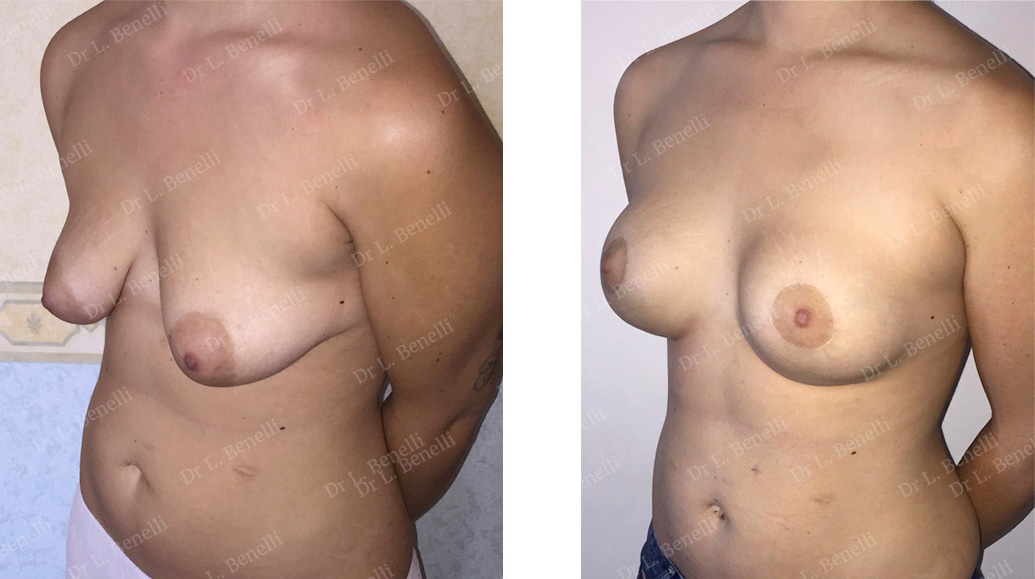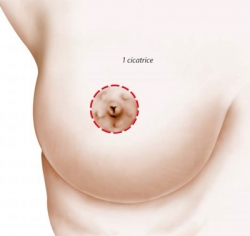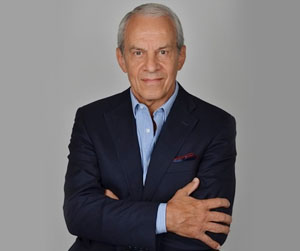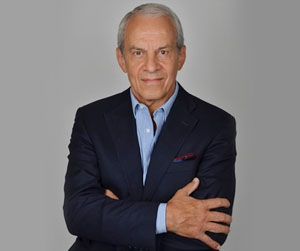Tuberous breast treatment
Tuberous breasts are a congenital malformation that appears at puberty during breast development.
This malformation corresponds to a particular shape of the breast and areola. The entire breast is supported by a very small base, creating a hernia-like appearance across the areola, which is dilated and often drooping.
This particular aspect is unsightly and worries teenagers, usually creating a complex and causing them aesthetic and personal embarrassment. This is because of the importance of the breast in the image of femininity and the female psyche, especially in this period when body image is so important.
This anomaly is usually poorly tolerated and an adolescent will very quickly ask for it to be corrected. However, we have to wait until puberty is completely over and the breast has been stable for over a year.

Tuberous breast correction and areola reduction using the periareolar Round Block technique and prosthesis.
Tuberous breasts are often asymmetrical and the deformity is more or less accentuated on one side compared to the other, with the volume and position of the breasts on the thorax often different.
It is possible to correct this malformation to obtain symmetrical breasts in terms of volume, shape, position and general appearance, with a contour that's in harmony with the patient's physique and her wishes.
In some cases, only one breast is tuberous and if the second is acceptable for the patient, it will serve as a model to make the other breast match. Alternatively, both can be operated on if the patient wishes.
One problem should not create another and the surgical procedure should leave very few marks, in particular leaving the smallest and most discreet scars.
Conventional plastic breast surgery sometimes leaves extensive scars (around the areola, vertically under the areola, and horizontally in the fold under the breast). This is why, in an effort to reduce the scarring often associated with traditional cosmetic breast surgery, I have developed the "Round Block" technique, which leaves only a simple scar around the areola, an area where healing is usually of good quality and not very visible because the scar blends with the edge of the areola. This is due to differences in colour and relief between the skin of the areola and the skin of the breast, without vertical scarring under the areola or in the sub-mammary fold.
This technique will reduce areola and breast sagging. If necessary, it can also involve an increase or decrease in breast volume.
This new breast harmony is a balancing factor and helps with self-confidence, whether the body is naked or clothed.
Uses
This problem is normally poorly tolerated and an adolescent will soon be asking for it to be corrected. However, we have to wait until puberty is completely over and the breast has stabilised for over a year.
There are many variations in the shape of tuberous breasts, even in the same patient who may have significant asymmetry.
Each person arrives with a request for correction of a particular defect that is particularly troublesome to them. The objective of the operation will be to correct this defect as a priority by assessing whether it may be appropriate to correct other associated defects to have a well-balanced, natural result that meets expectations.
So, depending on the insights gained during the first consultation, the operation may consist of one or more of these operations at the same time:
-
Areola reduction,
-
Remodelling of the glandular content of the breast to distribute it over the entire normal base of the breast in relation to the thorax, whereas in a tuberous breast, the base is significantly reduced and the breast volume does not normally cover the rib cage,
-
A breast lift,
-
Breast augmentation or breast reduction.

Tuberous breast correction and breast lift using the Round Block periareolar technique and prostheses
Consultation
During the first consultation, it is essential that you openly express what bothers you and what you would like to improve. Do not be afraid to ask any questions, including expressing your fears and expectations. Everyone has a different body shape, psychology and expectations. These are not the same and there is no standard to apply.
After you have explained your motivations, I will examine you and propose one or more solutions, taking into account your expectations, your anatomy, respecting your identity and the natural aspect of your appearance.
The technique to be used is evaluated at the first consultation, favouring the choice of a technique that will leave as few scars as possible.
During the first consultation, I will evaluate the technique to use that leaves as little scarring as possible.
So you can visualise the desired result, I will show you photos of surgical results from cases similar to yours so you can understand the objective of the procedure.
It is essential that you and I have a good understanding in order to make the decision to operate and to determine the technique to use among those I can offer.
I will then give you all the information on the techniques proposed along with the information sheets from the Société Française de Chirurgie Plastique Reconstructrice et Esthétique (French Society of Plastic, Reconstructive and Cosmetic Surgery) as well as a detailed estimate of the costs for the options chosen. You will then be able to progress your project and get ready for a second consultation when you will be able to ask any additional questions to help you make a decision and prepare for the operation.
Before the procedure
Pre-operative examinations should be carried out:
-
Breast ultrasound and/or mammography to check breast health. These will allow any anomalies to be picked up and these may be treated during the operation or may possibly lead to additional pre-operative examinations.
-
A blood test, if necessary, depending on the type of anaesthesia (local or general).
In the case of a general anaesthetic, you will need a consultation with the anaesthetist in the weeks preceding the operation and at least 48 hours before.
You will be prescribed a bra to buy, which is specifically suited to post-operative restraint. You must bring this on the day of the operation to be worn the end of the operation.
Recommendations
No medications containing aspirin or anti-inflammatories can be taken within 10 days of the procedure.
For general anaesthetic, you will have to fast strictly for 6 hours before the operation (do not eat anything, chew gum, eat sweets or smoke).
Smoking can cause scarring problems.
The procedure
Hospitalisation and the duration of the procedure:
Your stay in hospital is usually limited to the night following the operation. Same-day discharge is also possible after a few hours of monitoring following the operation. During the night, painkillers and analgesics are given by drip if you are staying in hospital or are taken in tablet form at home. Going home the next day, you will need to wear a simple, specially-adapted support bra.
The duration of the operation varies according to the anomalies I need to correct and ranges from 30 minutes to 2.5 hours.
Type of anaesthetic
Deep local (neuroleptanalgesia) or general according to your preferences.
Technique
Before you go to the operating theatre, in your room, I will go over the precise goals with you as we agreed during the consultations. You can then always make recommendations and ask any questions. I will then draw the lines and marks on your skin to guide the operation and the lines of the incisions.
The principle of tuberous breast correction is:
-
Reducing the tuberous areola to a normal diameter, which is on average 3.5 cm and repositioning it on the new curve,
-
Reshaping the glandular content of the breast to give it the desired volume by augmentation or reduction, depending on each case. Then, distributing this volume over the entire normal base of the breast in relation to the thorax, whereas a tuberous breast has a significantly reduced base and the breast volume does not normally cover the rib cage.
This reduction and repositioning of the areola, with breast enhancement, is carried out using the "Round Block" technique. This technique has the advantage of leaving only a simple scar around the areola, an area where healing is usually of good quality and not very visible because the scar blends with the areola's circumference due to the differences in colour and relief between the skin of the areola and the skin of the breast. Therefore, there is no vertical scar under the areola or in the sub-mammary fold. I developed this "Round Block" technique to reduce the often extensive scarring of traditional plastic breast surgery. In addition, the "Round Block" technique allows the skin to be normally repositioned around the areola and avoids any enlargement or deformation of the areola, a major disadvantage of the old periareolar techniques. Then, a deep periareolar support wire is put in place to support the diameter of the areola in the long term, allowing the skin around the areola to adapt as much as possible and leaving a simple circular periareolar scar.

I can use several techniques during the same operation depending on the type of tuberous breasts to treat. For a description of the technique and the after-effects of the operation, please refer to the various pages concerned: areola reduction, breast augmentation, breast reduction, breast lift, "Round Block".
Note that, in these young patients who require breast augmentation, the technique of lipofilling (injecting your own fatty tissue) breast augmentation technique is preferred.
The stitches are placed in the skin’s thickness (intradermal stitch) and are, therefore, invisible. These stitches are absorbable so they do not need to be removed.
At the end of the operation, a suction drainage is set up to limit hematoma formation, a bandage is applied to the scar, and a support bra is put in place.
After the operation
During the night and days following the operation, there may be a painful sensation of tension in the area that was operated on, such as aches and pains, which may impede mobility. These pains are moderate in a resting position and may require analgesics, which are given by drip if you are staying in hospital or are taken as tablets at home. These post-operative pains will diminish and disappear within a few days of the operation.
The drainage will be removed the day after the operation.
The dressing will be completely removed during the first post-operative consultation about a week after the operation and replaced by a waterproof adhesive dressing, allowing you to take a shower. You will need to change this every 8 days.
As the stitches used are absorbable, they do not need to be removed. Placed internally in the skin’s thickness (intradermal stitches), they are invisible.
Swelling (oedema) and bruising around the thoracic area are usually very moderate and it takes about ten days for these to disappear almost completely.
You will need to take about 4 to 5 days off work in the majority of cases.
Care
In addition to wearing the support bra day and night for 1 month, you will need to wear a waterproof dressing when taking showers and this should be changed every 8 days over a period of 1 month.
You will need to attend a follow-up consultation about a week after the procedure, then after 15 days, 1 month, 3 months, 6 months, and 1 year.
Recommendations
-
Do not raise your arms too high and avoid heavy physical exertion.
- You may resume sporting activities about 1 month after the operation, wearing a support bra and limiting yourself to painless movements.
-
The recommended rest position is lying on your back, slightly raised if possible. You can also lie on your side but must not lie on your front.
-
Exposure to the sun: no direct exposure before 1 month and then exposure is allowed using a sun protection cream with a maximum sun protection factor. No exposure as long as there are bruises or the scar is pink.
-
Pregnancy and breastfeeding: Breastfeeding is possible. However, it is advisable to wait for 6 months before considering a pregnancy so that the breast is fully settled.
The result
The result is immediately visible despite any swelling and will improve in the weeks following the operation.
In the long term, the result will be stable and sustainable.
Young patients are very glad that this malformation has been corrected as it will have bothered them significantly and there is only a very discreet scar around the areola with a spectacular aesthetic improvement.
In addition to this aesthetic improvement, the operation has a beneficial impact on the patient’s personal well-being, behaviour and development and they have been relieved of their previous problem.
Risks and complications
Price range
The cost of the operation will depend on the procedure to be carried out, the duration of the operation, the type of anaesthetic and any hospital charges.
You may be covered by Social Security and, if necessary, by your mutual insurance company after prior agreement by the Medical Adviser of the Primary Health Insurance Fund if there is a need for simultaneous breast augmentation or in cases of significant asymmetry.
On the other hand, if the reason for the operation is purely aesthetic, you will not have the right to Social Security reimbursement.
A detailed estimate is given to you during the first consultation following the options you have chosen. You then have a minimum legal period of 15 days to consider your options and move your project forward.
The first consultation costs €50. The follow-up consultations before and after the operation are free.
The photographs on this page are to illustrate and complete the information given on the operations. They are merely for information purposes so you can see the goals, results and scars from the operation.
The likelihood of scarring and each patient’s individual anatomy are different. For this reason, therefore, the photographs on this site do not commit Dr. Benelli to providing all patients with a similar result.
The information given on a site is not sufficient in itself and a medical consultation is essential to get the right information for each individual case. For this, you will need to consult a surgeon qualified in Plastic Reconstructive and Aesthetic Surgery.



